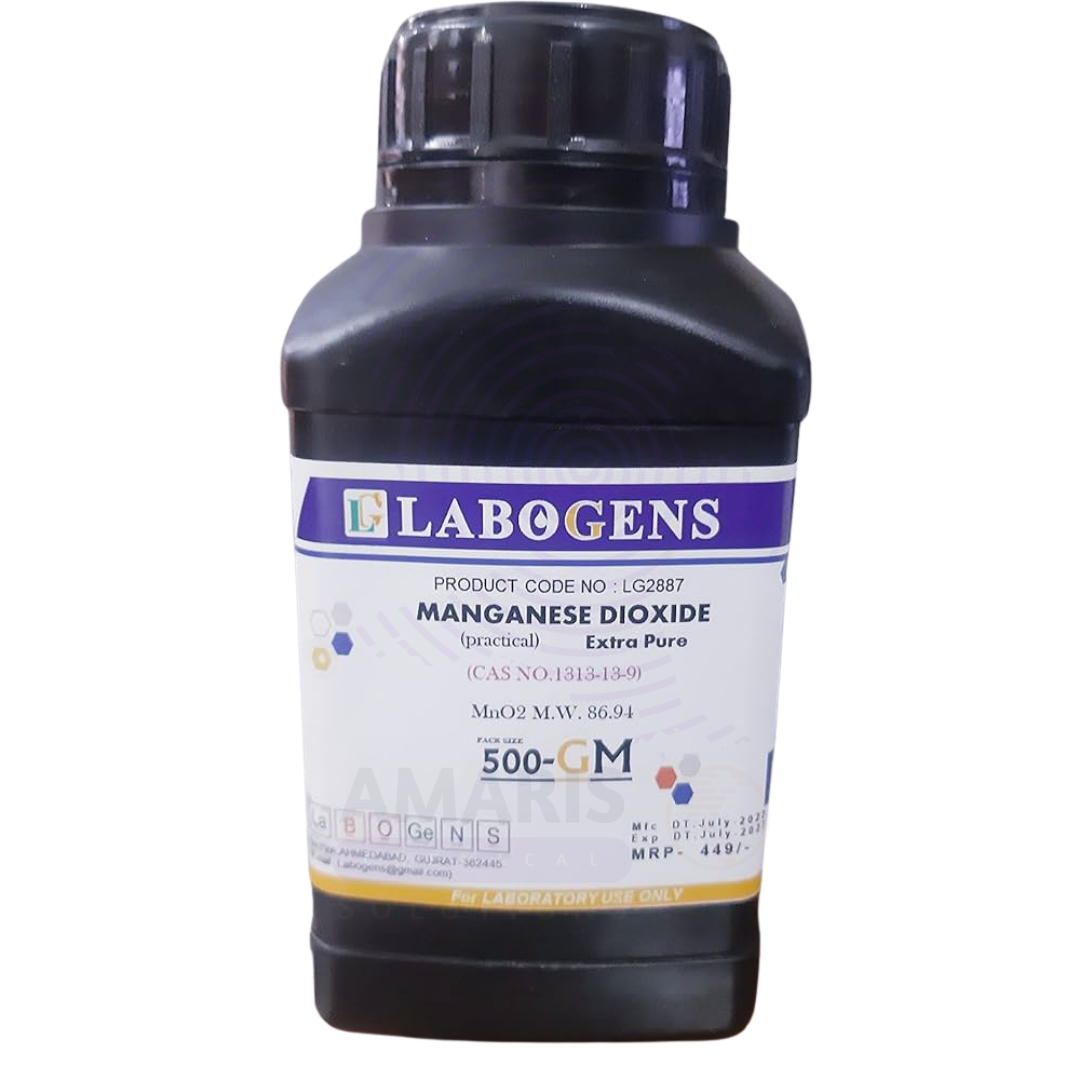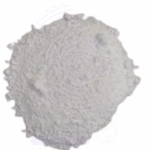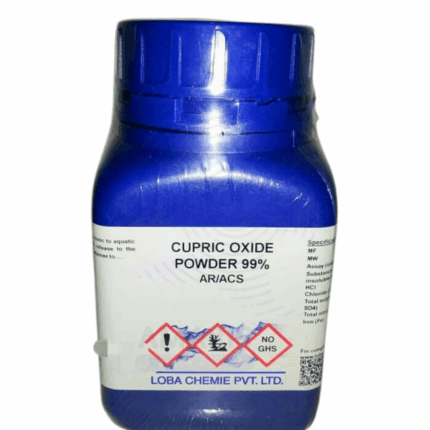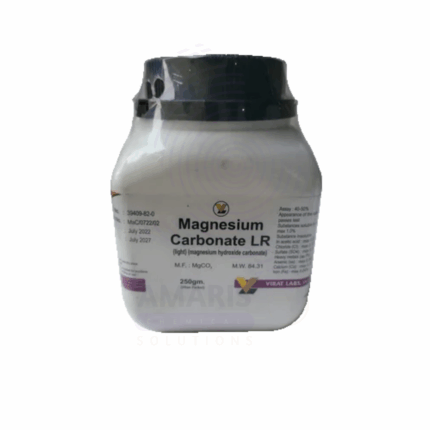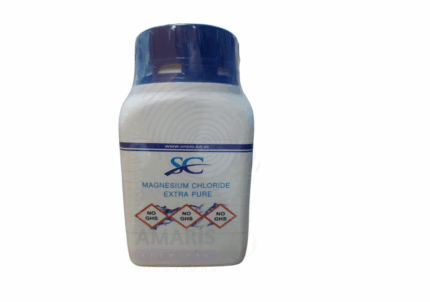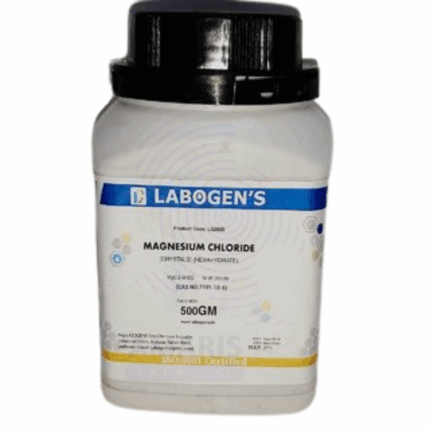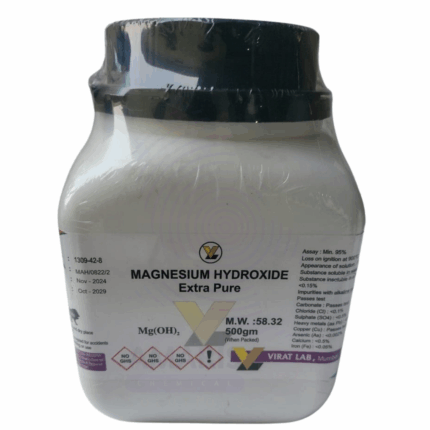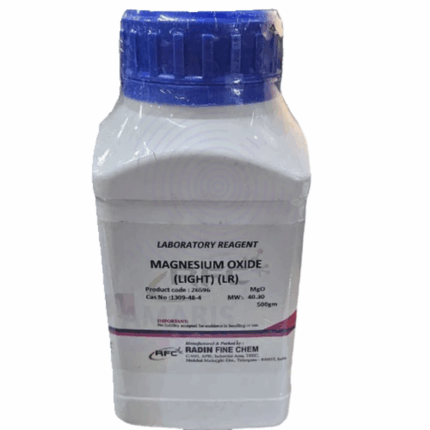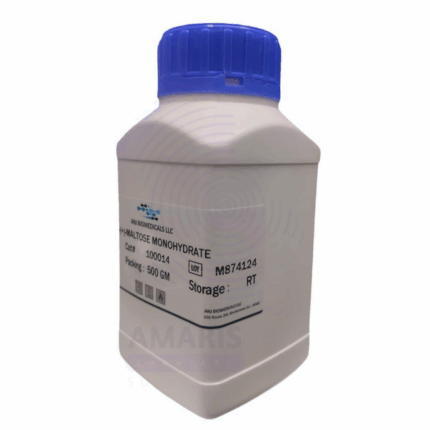
Manganese Dioxide Extra Pure
$ 18.00 Original price was: $ 18.00.$ 17.89Current price is: $ 17.89.
Manganese Dioxide Extra Pure is a high-purity, dark brown or black powder widely used in laboratories and industrial processes for its strong oxidizing properties. In analytical chemistry, it serves as an effective oxidizing agent and is often involved in the decomposition of hydrogen peroxide and other redox reactions. It is also used in the preparation of oxygen and chlorine gases in laboratory settings. Beyond the lab, manganese dioxide plays a crucial role in battery manufacturing, particularly in dry cell batteries, and in ceramics and glass production for coloring and decolorizing. Its consistent purity makes it ideal for sensitive experiments and formulations.
Manganese Dioxide Extra Pure
Primary Uses
- Strong Oxidizing Agent:
- Commonly used in redox reactions and organic oxidation experiments, such as converting alcohols to ketones or aldehydes.
- Decomposition of Hydrogen Peroxide:
- Serves as a catalyst to decompose H₂O₂ into water and oxygen, often used in demonstrations of catalytic reactions.
Secondary Uses
- Battery Research:
- Studied in electrochemistry as a component of dry cell batteries and for lithium battery cathodes.
- Pigment and Material Science:
- Used in experiments involving ceramic glazes or glass coloration due to its pigmenting properties.
- Gas Generation Reactions:
- Assists in laboratory setups for generating oxygen gas during chemical demonstrations.
| PACK SIZE |
100 grams Plastic Tin |
|---|
1. Basic Identification Attributes
- Chemical Name: Manganese Dioxide
- Synonyms: Pyrolusite, Manganese(IV) oxide
- CAS Number: 1313-13-9
- Molecular Formula: MnO₂
- Molecular Weight: 86.94 g/mol
- Appearance: Black or dark brown powder
- Odor: Odorless
- Solubility: Insoluble in water and alcohol
- Grade: Extra Pure
2. Safety & Hazard Attributes
- GHS Classification:
- Health hazard (Chronic)
- Environmentally hazardous (Aquatic chronic)
- Hazard Statements:
- H373: May cause damage to organs through prolonged or repeated exposure
- H411: Toxic to aquatic life with long-lasting effects
- Precautionary Statements:
- P260: Do not breathe dust
- P273: Avoid release to the environment
- P281: Use personal protective equipment as required
- Personal Protective Equipment (PPE):
- Lab coat
- Gloves
- Safety goggles
- Dust mask or respirator (if dust is generated)
- First Aid Measures:
- Inhalation: Move to fresh air; seek medical attention if symptoms persist
- Skin Contact: Wash thoroughly with soap and water
- Eye Contact: Rinse cautiously with water for several minutes
- Ingestion: Rinse mouth; seek medical attention
- Fire Hazards:
- Non-flammable, but may react with combustible materials
- Use appropriate extinguishing media for surrounding fire
3. Storage & Handling Attributes
- Storage Conditions:
- Store in a cool, dry, and well-ventilated area
- Keep container tightly closed
- Avoid storage near acids and reducing agents
- Handling Tips:
- Minimize dust generation
- Avoid contact with incompatible substances
- Handle with care in designated chemical areas
4. Laboratory Applications
- Primary Uses:
- Oxidizing agent in organic and inorganic synthesis
- Reagent in analytical chemistry
- Decomposition of hydrogen peroxide in catalytic experiments
- Secondary Uses:
- Manufacture of dry-cell batteries (Leclanché cells)
- Glass and ceramics coloring agent
- Laboratory preparation of chlorine and oxygen gases
SAFETY PRECAUTIONS
Personal Protective Equipment (PPE):
- Wear a lab coat, nitrile gloves, and safety goggles.
- Use a dust mask or operate in a fume hood to avoid inhalation.
Handling:
- Avoid contact with skin, eyes, and clothing.
- Do not breathe dust. Prevent dust generation.
- Wash hands thoroughly after handling.
- Handle in accordance with good industrial hygiene and safety practices.
Storage:
- Store in a cool, dry, and well-ventilated location.
- Keep the container tightly closed and away from incompatible materials (e.g., strong acids and reducing agents).
- Protect from moisture and direct sunlight.
FIRST AID MEASURES
Inhalation:
- Move people to fresh air.
- Get medical attention if respiratory symptoms occur.
Skin Contact:
- Wash with soap and water.
- Remove contaminated clothing.
- Seek medical advice if irritation develops.
Eye Contact:
- Rinse thoroughly with plenty of water for at least 15 minutes.
- Remove contact lenses if present and easy to do.
- Seek medical attention if irritation persists.
Ingestion:
- Rinse mouth with water.
- Do not induce vomiting.
- Get medical attention if symptoms occur.
FIRE FIGHTING MEASURES
Flammability:
- Non-flammable, but may enhance combustion of other materials due to oxidizing nature.
Extinguishing Media:
- Use dry chemical, CO₂, foam, or water spray as appropriate for surrounding fire.
Hazardous Combustion Products:
- May release manganese oxides if involved in fire.
Firefighter Protection:
- Wear self-contained breathing apparatus (SCBA) and full protective gear.


 Preservatives(food)
Preservatives(food) Flavor Enhancers
Flavor Enhancers Acidulants
Acidulants Sweeteners
Sweeteners Antioxidants
Antioxidants Colorants(food)
Colorants(food) Nutraceutical Ingredients (food)
Nutraceutical Ingredients (food) Nutrient Supplements
Nutrient Supplements Emulsifiers
Emulsifiers
 Collectors
Collectors Dust Suppressants
Dust Suppressants Explosives and Blasting Agents
Explosives and Blasting Agents Flocculants and Coagulants
Flocculants and Coagulants Frothers
Frothers Leaching Agents
Leaching Agents pH Modifiers
pH Modifiers Precious Metal Extraction Agents
Precious Metal Extraction Agents
 Antioxidants(plastic)
Antioxidants(plastic) Colorants (Pigments, Dyes)
Colorants (Pigments, Dyes) Fillers and Reinforcements
Fillers and Reinforcements Flame Retardants
Flame Retardants Monomers
Monomers Plasticizers
Plasticizers Polymerization Initiators
Polymerization Initiators Stabilizers (UV, Heat)
Stabilizers (UV, Heat)
 Antifoaming Agents
Antifoaming Agents Chelating Agents
Chelating Agents Coagulants and Flocculants
Coagulants and Flocculants Corrosion Inhibitors
Corrosion Inhibitors Disinfectants and Biocides
Disinfectants and Biocides Oxidizing Agents
Oxidizing Agents pH Adjusters
pH Adjusters Scale Inhibitors( water)
Scale Inhibitors( water)
 Antioxidants(cosmetic)
Antioxidants(cosmetic) Emollients
Emollients Fragrances and Essential Oils
Fragrances and Essential Oils Humectants
Humectants Preservatives
Preservatives Surfactants(cosmetic)
Surfactants(cosmetic) Thickeners
Thickeners UV Filters
UV Filters
 Fertilizers
Fertilizers Soil Conditioners
Soil Conditioners Plant Growth Regulators
Plant Growth Regulators Animal Feed Additives
Animal Feed Additives Biostimulants
Biostimulants Pesticides (Herbicides, Insecticides, Fungicides)
Pesticides (Herbicides, Insecticides, Fungicides)
 Active Pharmaceutical Ingredients (APIs)
Active Pharmaceutical Ingredients (APIs) Excipients
Excipients Solvents(pharmaceutical)
Solvents(pharmaceutical) Antibiotics
Antibiotics Antiseptics and Disinfectants
Antiseptics and Disinfectants Vaccine Adjuvants
Vaccine Adjuvants Nutraceutical Ingredients (pharmaceutical)
Nutraceutical Ingredients (pharmaceutical) Analgesics & Antipyretics
Analgesics & Antipyretics
 Analytical Reagents
Analytical Reagents Solvents(lab)
Solvents(lab) Chromatography Chemicals
Chromatography Chemicals Spectroscopy Reagents
Spectroscopy Reagents microbiology-and-cell-culture-reagents
microbiology-and-cell-culture-reagents Molecular Biology Reagents
Molecular Biology Reagents Biochemical Reagents
Biochemical Reagents Inorganic and Organic Standards
Inorganic and Organic Standards Laboratory Safety Chemicals
Laboratory Safety Chemicals Specialty Laboratory Chemicals(Special Laboratory Equipment)
Specialty Laboratory Chemicals(Special Laboratory Equipment)
 Demulsifiers
Demulsifiers Hydraulic Fracturing Fluids
Hydraulic Fracturing Fluids Scale Inhibitors(oil)
Scale Inhibitors(oil) Surfactants(oil)
Surfactants(oil) Drilling Fluids
Drilling Fluids
 Dyes and Pigments
Dyes and Pigments Bleaching Agents
Bleaching Agents Softening Agents
Softening Agents Finishing Agents
Finishing Agents Antistatic Agents
Antistatic Agents
 Admixtures
Admixtures Waterproofing Agents
Waterproofing Agents Sealants and Adhesives
Sealants and Adhesives Curing Compounds
Curing Compounds Concrete Repair Chemicals
Concrete Repair Chemicals Anti-Corrosion Coatings
Anti-Corrosion Coatings
 Surfactants(cleaning)
Surfactants(cleaning) Builders
Builders Enzymes
Enzymes Solvents (Cleaning)
Solvents (Cleaning) Fragrances
Fragrances
 Electronic Chemicals
Electronic Chemicals Catalysts
Catalysts Lubricants
Lubricants Photographic Chemicals
Photographic Chemicals Refrigerants
Refrigerants Automotive chemicals
Automotive chemicals Pyrotechnic Chemicals
Pyrotechnic Chemicals
 Biodegradable Surfactants
Biodegradable Surfactants Bio-based Solvents
Bio-based Solvents Renewable Polymers
Renewable Polymers Carbon Capture Chemicals
Carbon Capture Chemicals Wastewater Treatment Chemicals
Wastewater Treatment Chemicals
 Pigments
Pigments Solvents(paint)
Solvents(paint) Specialty Coatings
Specialty Coatings Binders/Resins
Binders/Resins Additives
Additives Driers
Driers Anti-Corrosion Agents
Anti-Corrosion Agents Functional Coatings
Functional Coatings Application-Specific Coatings
Application-Specific Coatings
 Fresh Herbs
Fresh Herbs Ground Spices
Ground Spices Whole Spices
Whole Spices Spice Blends
Spice Blends Dried Herbs
Dried Herbs
 Leavening Agents
Leavening Agents Dough Conditioners
Dough Conditioners Flour Treatments
Flour Treatments Fat Replacers
Fat Replacers Decoratives
Decoratives Preservatives(baking)
Preservatives(baking)
 Plasticizers & Softeners
Plasticizers & Softeners Reinforcing Agents
Reinforcing Agents Adhesion Promoters
Adhesion Promoters Vulcanizing Agents
Vulcanizing Agents Antidegradants
Antidegradants Blowing Agents
Blowing Agents Fillers & Extenders
Fillers & Extenders Accelerators & Retarders
Accelerators & Retarders